Lodging of rice in Egypt reduces production and may be related to the agronomic practices. A 2-years field experiment was conducted at the Experimental Farm of Rice Research and Training Center, Kafr El-Sheikh, Egypt, during two growing summer seasons of 2013 and 2014 to study the effect of growth regulators application at different nitrogen levels on lodging resistance and productivity of Sakha102 rice cultivar. Nitrogen levels 0, 110 and 165 kg N ha-1 in the form of urea (46.5%N) were allocated in the main plots while, growth regulators and potassium sulfate (48% K2O) were allocated in the subplots. Growth regulators (Cycocel and benzyladenine) and K2O were applied as foliar application at 15 and 30 days after transplanting. Cycocel, benzyladenine and K2O were applied at the concentration of 80 ppm, 15 ppm and 2%, respectively. Data indicated that most of the studied characters increased significantly by nitrogen and growth regulators application. Application of nitrogen increased lodging area, while application of different growth regulators reduced the rice lodging area especially at the high level of nitrogen. Leaf area index at 50 days after transplanting (DAT), plant height (cm) at harvest, number of panicles m-2, grain yield t ha-1 and NPK uptake were correlated significantly and positively with lodging area percentage, while 1,000-grain weight (g) correlated significantly and negatively with lodging area percentage.
Rice (Oryza sativa) is a stable food and plays a major role in feeding people in Egypt. Rice requires nitrogen for its growth and development. The role of nitrogen as a key factor to attain optimum yield of rice is undeniable. Application of high rate of nitrogen may cause lodging. Lodging is one of the most serious problems facing rice cultivation. Bridgemohan and Bridgemohan (2014) reported that lodging is a severe problem in rice, and is influenced by cultivar, production system, irrigation, nutrition, and weather conditions. Lodging is characterized by the reduction in plant canopy and the bending or fall over of mature plants with panicles on the soil or water resulting in yield and quality decline. It may be induced by variations in crop nutrition, water management, susceptible tall varieties and windy conditions. In all cases, the plant stem base is unusually weak with a reduced diameter. Adjustment of plant growth and development using plant growth retardants such as cycocel to reduce the plant height and increase the tolerance to lodging is a simple technique permitting the greater amount of nitrogen to attain higher yield.
Egyptian rice varieties may suffer lodging in their ripening stage which results in considerably reducing grain yield and quality. Lodging has long been recognized as a vital factor in growing rice plants and its importance has been greatly accentuated. Okuno et al. (2014) reported that traditional varieties of wheat and rice grow excessively tall when fertilizer is abundant and become susceptible to lodging, resulting in significant yield loss. In contrast, varieties with short stature are resistant to lodging even when fertilized excessively, and thus are capable of supporting their own body even if high grain yielding trait is introduced. Sedeek et al. (2009) indicated that plant height of Sakha102 ranged from 106 to 107 cm and it was one of the tallest varieties in Egypt.
Adjustment of plant growth and development using growth reducers such as Cycocel to reduce the plant height and increase the tolerance to lodging is a technique permitting the greater amount of nitrogen to attain higher yield (Mohaghegh, 2007). Most common utilized aniumic compounds are cycocel and mpiquate chloride. These compounds prevent the cyclic conversion of geranial pyrophosphate to copayol prophosphate and gradually they will be inhibitors of gibberellin. A major applying of plant growth reducers in agriculture is controlling the lodging of grain cereals like wheat, rice, rye and barley. At present between growth reducers, cycocel has the greatest consumption rate (Dobermann and Cassman, 2002). Cycocel is between most wide spread growth reducer of plants particularly in Europe and recently is utilizing greatly to decrease the lodging and to control the crop growth (Emam, 2003).
Metwally and Gharib (2011) revealed that foliar spray of potassium twice; at mid-tillering and panicle initiation stages resulted in a significant increase in rice plant height, dry matter accumulation (g m-2), number of panicles m-2, panicle weight (g), panicle length (cm), number of filled grains per panicle, 1,000-grain weight (g), grain yield (t ha-1) and nutrients uptake (N, P, K and Zn) by grains compared with control (without potassium application). The main objective of this study was to improve lodging resistance of Sakha102 rice cultivar by application of growth regulators (cycocel and benzyladenine) and K2O under different rates of nitrogen fertilizer.
Split plot design with four replications was used. Nitrogen levels were allocated in the main plots, while growth regulators were allocated in the subplots. Nitrogen at 0, 110 and 165 kg N ha-1 in the form of urea (46.5% N) was applied in two splits, two third as basal application and incorporated into the soil, then the soil was immediately flooded. The second dose (one third) were top dressed 25 days after transplanting (DAT). Growth regulators were applied as foliar application at 15 and 30 DAT. Cycocel, benzyladenine and K2O were applied at the concentration of 80 ppm, 15 ppm and 2%, respectively. Representative soil samples were taken at the depth of 0 to 30 cm from the soil surface. The procedure of soil analysis followed the methods of Black et al. (1965). Results of chemical analysis in both seasons are shown in Table 1.
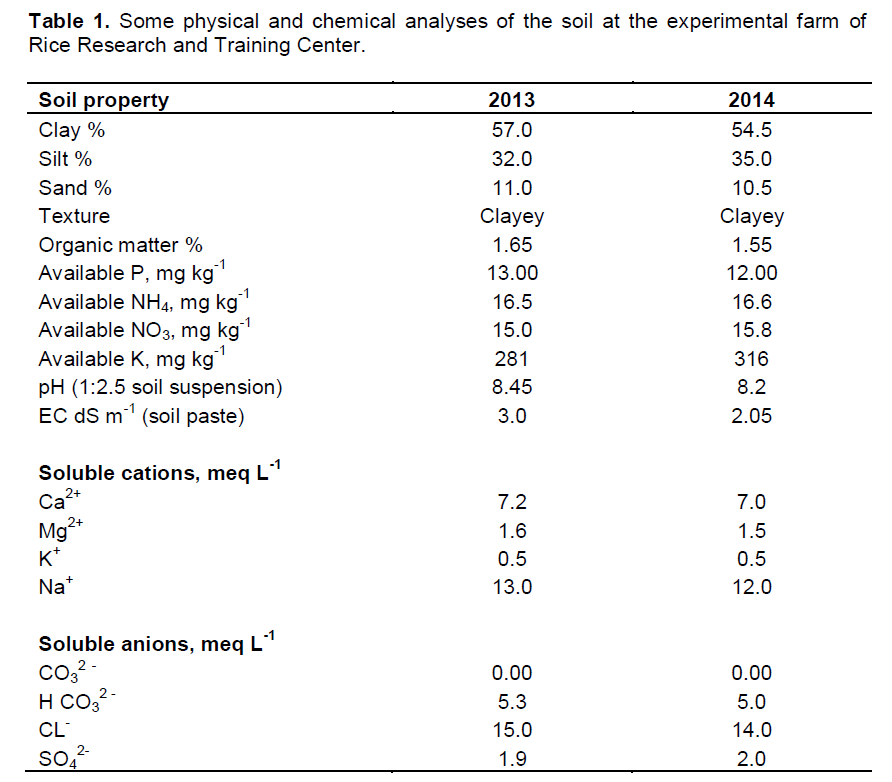
Seeds at the rate of 96 kg ha-1 were soaked in water for 24 h then incubated for 48 h to hasten early germination. Pre-germinated seeds were uniformly broadcasted in the nursery on May 6th and 2nd of 2013 and 2014, respectively. The permanent field was well prepared, that is, plowed twice followed by good wet leveling. Seedlings were carefully pulled from the nursery after 30 days from sowing and distributed through the plots. Seedlings were manually transplanted into 12 m2 subplots in 20 ´ 20 cm spacing at the rate of 2 to 3 seedlings hill-1. Seven days after transplanting, the herbicide Saturn 50% [S-(4-Chlorophenol methyl) diethyl carbamothioate] at the rate of 4.8 L ha-1 was mixed with enough amount of sand to make it easy for homogenous distribution. Plots were kept flooded (3-5 cm depth) till 2 to 3 weeks before harvesting. All other agronomic practices were followed as recommended during the growing season.
Fifty DAT, plant samples (five hills) were taken randomly from each plot to estimate dry matter accumulation and leaf area index (LAI). Dry matter accumulation (g m-2) was assessed by drying in the oven at 70°C for 72 h, and then, the total dry weight per m2 was computed. Leaf areas of 20 leaves were measured using leaf area meter, then these leaves were dried as well as the rest of five hill leaves (plant sample). By using the dry weight of the 20 leaves and its area and dry weight of the rest leaves, leaf area per hill was calculated. Then LAI was calculated using the following formula:
LAI = (Leaf area of fixed number of hills / Ground area occupied by these hills)
At maturity stage, five representative hills from each plot were separately sampled to determine plant height, number of panicles hill-1, panicle weight, panicle length, 1,000-grain weight, number of filled grain panicle-1 and number of unfilled spikelets panicle-1. At harvest, grain yield was estimated from 10 m2 and was expressed as t ha-1 at 14% moisture content. Grain samples were oven dry at 70°C till constant weight. Sub samples from grain were taken and then placed in bags and oven dry at 70°C for 48 h. Dried samples were ground to powder and digested by the wet oxidation procedures according to Johnson and Ulrich (1959) method. Nitrogen content in rice grain was determined by the Microkjeldahl method (Jackson, 1967). Total phosphorus content in grain was determined following the procedures of Watanabe and Olsen (1962). Total potassium content of grain was determined using the Flame Photometer according to Peterpurgski (1968) method. N, P and K uptake kg ha-1 were calculated. Lodging assessment was computed as percentage of area lodged.
The data were statistically analyzed with Fisher’s analysis of variance technique at 5% probability level; treatments were compared using a protected LSD test (Gomez and Gomez, 1984).
Dry matter accumulation (g m-2) 50 days after transplanting (DAT) was significantly affected by nitrogen and growth regulators application in both seasons (Table 2). Application of nitrogen increased significantly dry matter as compared with control. The greatest dry matter accumulation was obtained when rice received 165 kg N ha-1. Application of different growth regulators increased significantly dry matter accumulation. Cycocel produced the highest values of dry matter followed by K2O without significant differences. Metwally and Gharib (2011) found that foliar application of K2O at different growth stages increased dry matter accumulation of Egyptian hybrid rice.
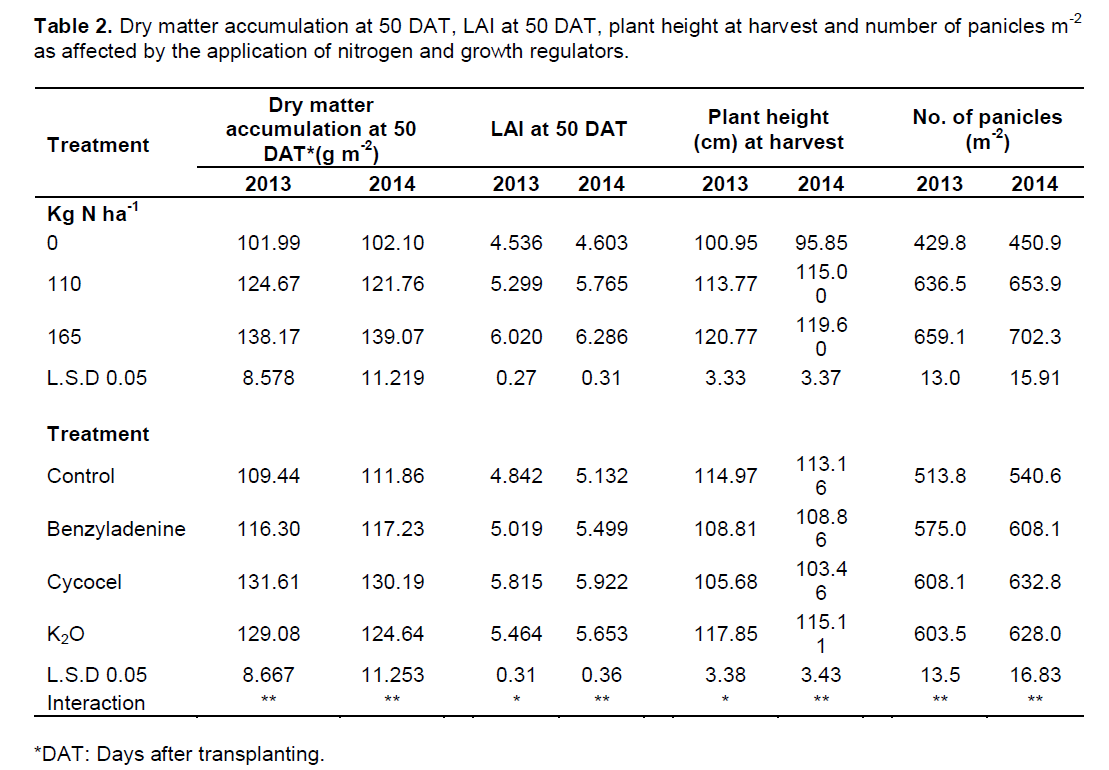
Concerning the interaction effect between nitrogen and growth regulators, data in Table 3 shows that dry matter accumulation was highly significant (P £ 0.01) affected by the interaction. The highest values of dry matter accumulation were observed when 165 kg N ha-1 was combined with cycocel followed by the combination between 165 kg N ha-1 and K2O. On the other hand, the lowest values of dry matter accumulation were found in the control (without nitrogen and growth regulators). Nitrogen application significantly affected leaf area index of Sakha102 rice plants at 50 DAT in both seasons (Table 2).

The highest values of leaf area index were found when nitrogen was applied at the rate of either 110 or 165 kg N ha-1. While, the lowest values were observed when nitrogen was not applied. This is mainly due to the fact that nitrogen is the major factor influencing leaf growth as it affects average leaf size, number of leaves per tiller and number of tillers per hill. These findings are similar to those of Metwally (2015). The application of growth regulators significantly affected leaf area index of rice plants. When rice plants received cycocel, the highest values of leaf area index were obtained with no significant difference between cycocel and K2O in second season only. On the other hand, the lowest values of leaf area index were obtained at control.
Data in Table 3 presents the effect of the interaction between nitrogen levels and growth regulators on leaf area index. Results showed that there was a significant effect on leaf area index in the two seasons due to the interaction between nitrogen and growth regulators. When nitrogen was applied at 165 kg N ha-1 in combination with cycocel, the highest values of leaf area index were obtained. This increase in leaf area index may be due to the increase in the plant canopy. However, the lowest values of leaf area index were obtained when neither nitrogen nor growth regulator was applied.
Plant height was found to be significantly affected by the application of nitrogen fertilizer in the two seasons (Table 2). Data indicated that plants received 165 kg N ha-1 exhibited significantly increase compared with those received 110 kg N ha-1 or planted under control (without N fertilizers). Increases in plant height due to nitrogen application could be mainly attributed to the role of nitrogen in the stimulation of cell division, internodes elongation and gibberellins activity. These findings are in close agreement with those reported by Metwally (2015).
Data reveal also that application of cycocel or benzyladenine reduced significantly plant height. Thus, the highest values of plant height were recorded when K2O was applied without any significant differences between K2O and control. The lowest values were obtained when either cycocel or benzyladenine was applied. Data in Table 3 showed that the interaction between nitrogen level and growth regulator had a significant effect on the plant height. The tallest plants were found in plots received 165 kg N ha-1 nitrogen fertilizer combined with either control or K2O. Roja Kohi et al. (2012), Unan et al. (2013), and Bridgemohan and Bridgemohan (2014) used growth regulators to control lodging in rice (Detail in R&D). They found that application of different concentrations of growth regulators reduced significantly plant height.
Data in Table 2 indicate also that nitrogen levels affected significantly number of panicles per m2. Increasing nitrogen levels from 0 up to 165 kg N ha-1 increased significantly number of panicles per m2. The effect of nitrogen application on number of panicles per m2 is attributed mainly to the stimulation effect of nitrogen on effective tillers formation. These findings are consistent with those reported by Metwally (2015). Data show also that growth regulators application increased significantly number of panicles per m2. The highest panicles per m2 were obtained when either cycocel or K2O was applied, while the lowest number of panicles was observed in control plots. These results are in agreement with those reported by Metwally and Gharib (2011) and Roja Kohi et al. (2012).
Concerning the effect of interaction, data in Table 3 show that number of panicles per m2 was significantly affected by the interaction between nitrogen fertilizers levels and growth regulators application. When nitrogen was applied at the rate of 165 kg N ha-1, combined with the application of cycocel, the greatest number of panicles per m2 was obtained. While, the lowest number of panicles per m2 was obtained when neither nitrogen nor growth regulator was applied. These results are in line with those of Tabatabaei and Akhgari (2014).
Data in Table 4 present the effect of the application of different levels of nitrogen and growth regulators on panicle weight in the two seasons. The application of nitrogen increased significantly panicles weight. Plants fertilized with 165 kg N ha-1 produced the heaviest panicle followed by the plants fertilized with 110 kg N ha-1. The lightest panicles were obtained when no nitrogen was applied. Panicle weight was significantly high when growth regulators were applied. Cycocel application recorded the heaviest panicles, while the lowest values were recorded when growth regulators were not applied.
Data in Table 5 show that there was a significant difference in panicle weight due to the interaction between nitrogen and growth regulators. The heaviest panicles were obtained in plants fertilized with 165 kg N ha-1 combined with cycocel. The lightest panicles were observed when nitrogen and growth regulators were not applied.
Data in Table 4 show the effect of the application of different levels of nitrogen and growth regulators on panicle length in the two seasons. Plots with 110 or 165 kg N ha-1 gave longer panicles than those of zero
nitrogen plots. Plants fertilized with 165 kg N ha-1 produced the longest panicles. The shortest panicles were obtained when nitrogen was not applied. Panicles were significantly longer in case of using growth regulators, compared to these without growth regulators. Data in Table 5 show that there was a significant difference in panicle length due to the interaction between nitrogen and growth regulators. The longest panicles were obtained when plants were fertilized with 165 kg N ha-1 combined with cycocel. The shortest panicles were observed when nitrogen and growth regulators were absent.
Thousand-grain weights as affected by the application of nitrogen and growth regulators are presented in Table 4. Data reveal that application of nitrogen significantly reduced the 1000-grain weight. Thus, the highest values of 1000-grain weight appeared when nitrogen was not applied and the lowest values were obtained when either 110 or 165 kg N ha-1 was applied. This is mainly due to the higher number of spikelets per panicle in plants received nitrogen at any of the rates than those without nitrogen. So, the sink capacity in zero nitrogen plots is high and the source is limited, therefore, the filling of grains will be more consequently the weight of grains will be high. These findings are in agreement with those reported by Metwally (2015).
The data indicate also that the application of different growth regulators significantly affected the 1000-grain weight. The highest values of 1000-grain weight were found when either benzyladenine or K2O was applied followed by cycocel, while the lowest values were obtained when growth regulators was not applied. Roja Kohi et al. (2012) indicated that cycocel application increased 1000-grain weight of rice. Metwally and Gharib (2011) found that foliar application of K2O increased 1000-grain weight of Egyptian hybrid rice.
The effect of the interaction between nitrogen and growth regulators on 1000-grain weight was significant in the two seasons of the study as shown in Table 5. The highest values of 1000-grain weight were obtained in non-fertilized plants whatever the growth regulator, while the lowest values were obtained at the higher level of nitrogen without growth regulators application. Similar trend was found by Tabatabaei and Akhgari (2014).
Number of filled grains per panicle as affected by nitrogen and growth regulators application is presented in Table 6. Data showed that number of grains per panicle increased significantly when nitrogen was applied. Growth regulators application showed significant effect on number of filled grains per panicle in both seasons. The highest number of filled grains per panicle was recorded by K2O followed by cycocel application. Bridgemohan and Bridgemohan (2014) found that growth regulators increased significantly grain filling of rice plant. They also reported that growth regulators (Paclobutrazol and Trinexapac-ethyl) are antagonist of the plant hormone gibberellin, and inhibiting gibberellin biosynthesis, thereby reducing inter-nodal growth to give stouter stems, increasing root growth, causing increasing grain filling.
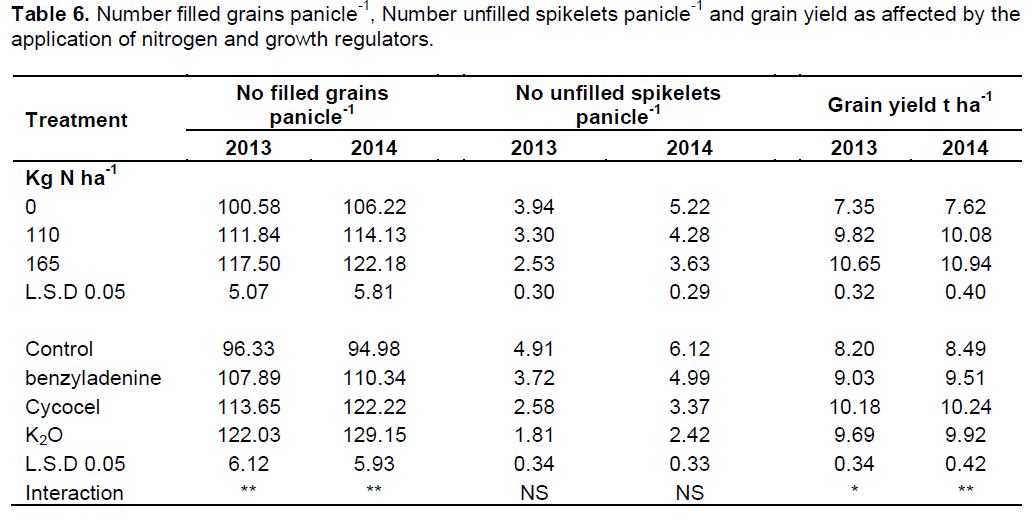
The effect of the interaction between nitrogen and growth regulators application on number of filled grains per panicle was significant in both seasons of study as shown in Table 7. The highest number of filled grains per panicle was recorded when nitrogen was applied at the rate of 165 kg N ha-1 combined with K2O application. On the other hand, the lowest number of filled grains per panicle was obtained when neither nitrogen nor growth regulator was applied.
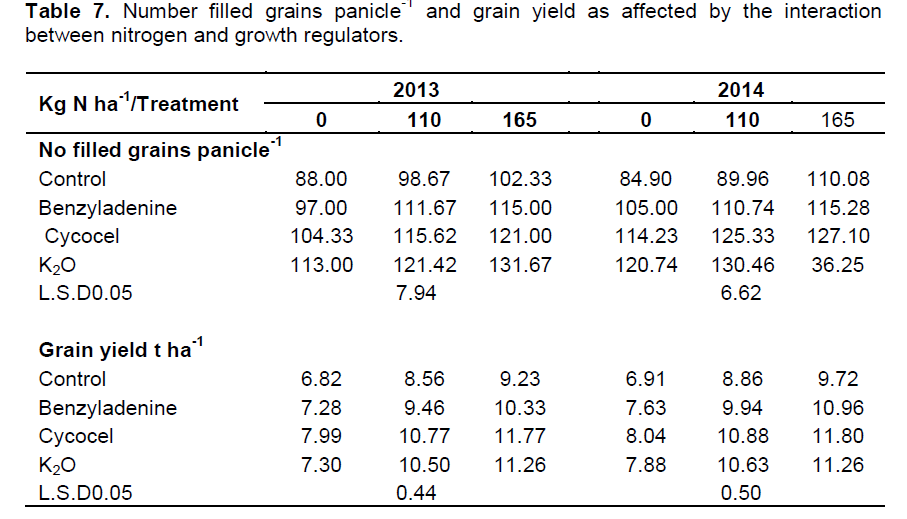
Data in Table 6 show that number of unfilled spikelets panicle-1 was significantly affected by nitrogen application. Plants fertilized with 165 kg N ha-1 produced the lowest values of unfilled spikelets panicle-1, while the plants that without nitrogen fertilizer gave the highest values of unfilled spikelets panicle-1. It could be concluded that nitrogen fertilization resulted in an increase in the amount of metabolites synthesized by rice plant and this, in turn, might account much for the superiority of filled grain percentage. These results were in the same trend in both seasons. The current results are in agreement with those obtained by Metwally (2015).
Growth regulators significantly affected number of unfilled spikelets panicle-1 in both seasons. The application of any of the growth regulators decreased unfilled spikelet percentage. K2O application recorded the lowest values of number of unfilled spikelets panicle-1. There was no significant difference in number of unfilled spikelets panicle-1 due to the interaction between nitrogen and growth regulators.
Data in Table 6 indicate also that there was a significant difference in grain yield due to nitrogen fertilizer application. Data showed significant increase in grain yield as nitrogen level increased from 0 up to 165 kg N ha-1. The increase in grain yield by increasing nitrogen level may be due to the increase in most of yield components. Similar conclusion was previously drawn by Metwally (2015).
Significant grain yield increases were observed for application of growth regulators. The highest values of grain yield were obtained when cycocel was applied followed by K2O. These results are in harmony with those reported by Roja Kohi et al. (2012), Unan et al. (2013) and Bridgemohan and Bridgemohan (2014) who observed that application of growth regulator increased significantly rice grain yield.
There was a significant effect on grain yield due to the interaction between nitrogen and growth regulators in the two seasons as shown in Table 7. Applications of nitrogen at the rate of 165 kg N ha-1 combined with cycocel were superior to other nitrogen and growth regulators combinations. While, the minimum values were obtained when neither nitrogen nor growth regulator was applied. The increase in grain yield is attributed mainly to the increase in most yield components, i.e. number of panicles m-2 and number of filled grains per panicle. Similar trend was found by Tabatabaei and Akhgari (2014).
N, P and K uptake by rice grain was affected significantly by nitrogen and growth regulators application as well as the interaction effect between nitrogen and growth regulators in the two seasons as shown in Tables 8 and 9. Data indicated that N uptake increased significantly with nitrogen application up to 165 kg N ha-1. Application of growth regulators increased significantly N uptake by rice grain. Cycocel application produced the highest values of N uptake followed by K2O without any significant differences. Regarding the interaction, data in Table 9 showed that the highest values of N uptake were found when nitrogen at the rate of 165 kg N ha-1 was combined with either cycocel or K2O. On the other hand, low N uptake was found in plots which didn’t receive any treatment.
P uptake by rice grain kg ha-1 increased by increasing nitrogen rate from 0 up to 165 kg N ha-1. The data showed also that application of different growth regulators increased significantly P uptake. The highest values of P uptake were found when either cycocel or K2O was applied. Concerning the effect of the interaction between nitrogen fertilizer level and growth regulators application, data in Table 9 showed that the highest values of nitrogen uptake were recorded when nitrogen was applied at the rate of 165 kg ha-1 combined with cycocel or K2O.
Nitrogen application increased significantly K uptake by rice grain kg ha-1. The highest values of K uptake were obtained when 165 kg ha-1 was applied. K uptake by rice grain kg ha-1 increased significantly by growth regulators. Application of K2O recorded the highest values of K uptake by rice grain kg ha-1 followed by cycocel application. Regarding the interaction effect, application of 165 kg ha-1 with K2O produced the highest values of K uptake by rice grain kg ha-1. While, the lowest values were recorded when neither nitrogen nor growth regulator was applied.
Effect of different treatments on lodging area percent is illustrated in Figure 1. Application of nitrogen increased area affected by lodging while, application of different growth regulators reduced the area percentage especially at the high level of nitrogen. Application of cycocel was superior to other growth regulators. Bridgemohan and Bridgemohan (2014) indicated that plant growth regulators act as inhibitors of the action of a key enzyme in the formation of gibberellic acid (GA1), preventing the formation of the plant growth regulator gibberellins which promotes cell elongation. In the absence of gibberellins, the internodes of the plants fail to grow and prevent the plant from growing taller. As a result they reduce or prevent lodging, and increase the yield in crops by redirecting energy into the production of reproductive parts. Unan et al. (2013) found that application of plat growth regulator decreased significantly lodging of rice plant. Roja Kohi et al. (2012) found that application of cycocel to rice plants increased the resistance to fracture. Growth regulators application increase plant resistance against lodging due to its ability to decreases the cell size and increases the cell wall thickness, increases the number of stem sets, decreases the length of internodes and increases the stem diameter. In addition, above mentioned properties increase the ability to use nitrogen manures in cereals (Mohsen Zadeh et al., 2003).
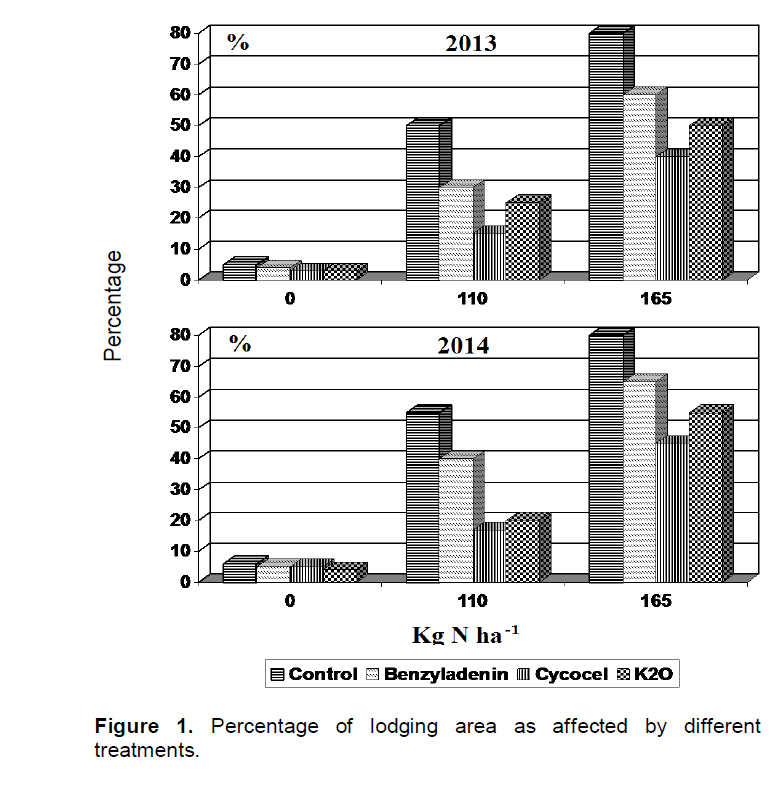
Data in Table 10 show the correlation coefficient between lodging area % and each of the studied characters. Over the two years, the traits that correlated significantly with lodging area percentage at 0.01 or 0.05 level were leaf area index at 50 DAT, plant height (cm) at harvest, number of panicles m-2, 1,000 grain weight (g), grain yield t ha-1 and NPK uptake. The most important correlation was between lodging and plant height (r =0.825**). Similar trend was found by Unan et al. (2013). On the other hand, the correlation was significantly negative between lodging area percentage and 1000 grain weight (r =-0.727**).

Lodging can be reduced following cycocel, benzyladenine and K2O application to Sakha102 Egyptian rice cultivar. Adequate application of nitrogen fertilizer combined with each of cycocel, benzyladenine or K2O leads to better growth and yield of rice. Further studies are needed to confirm the role of growth regulators on rice.